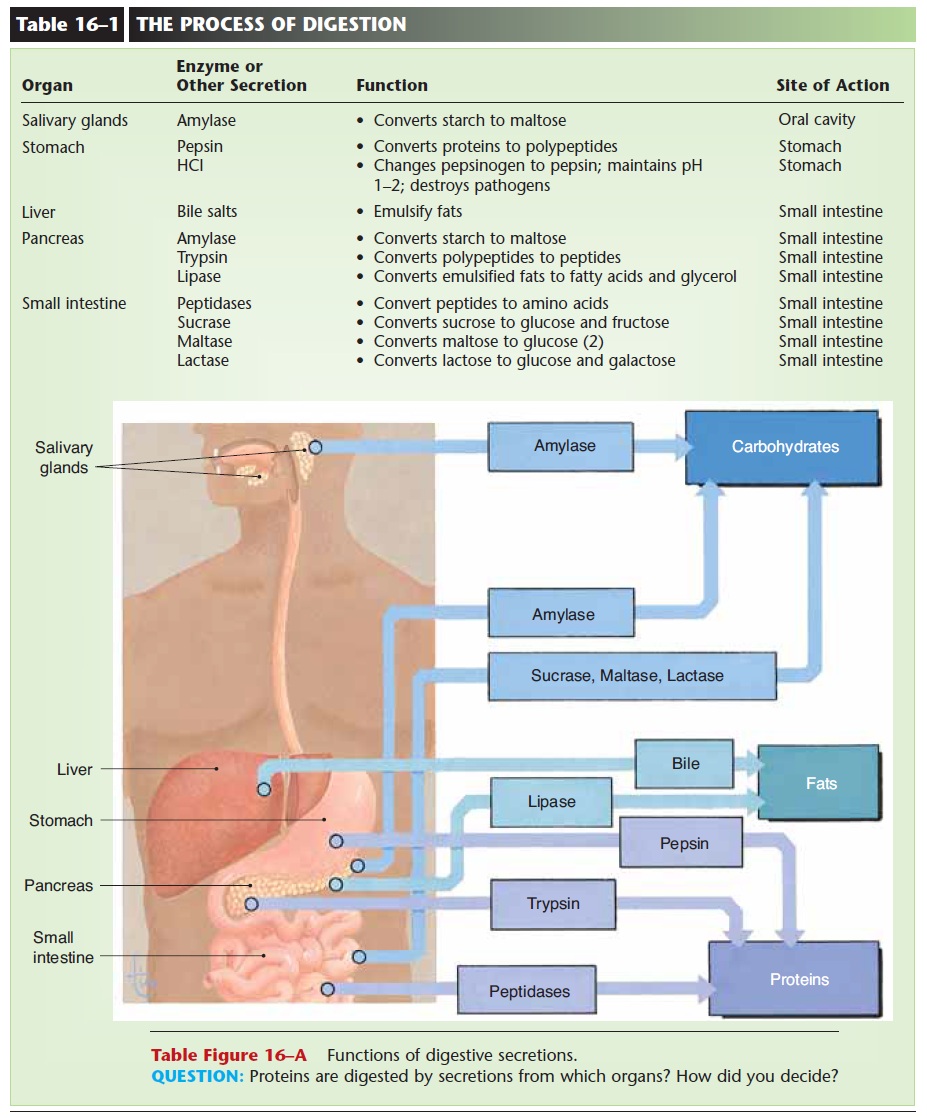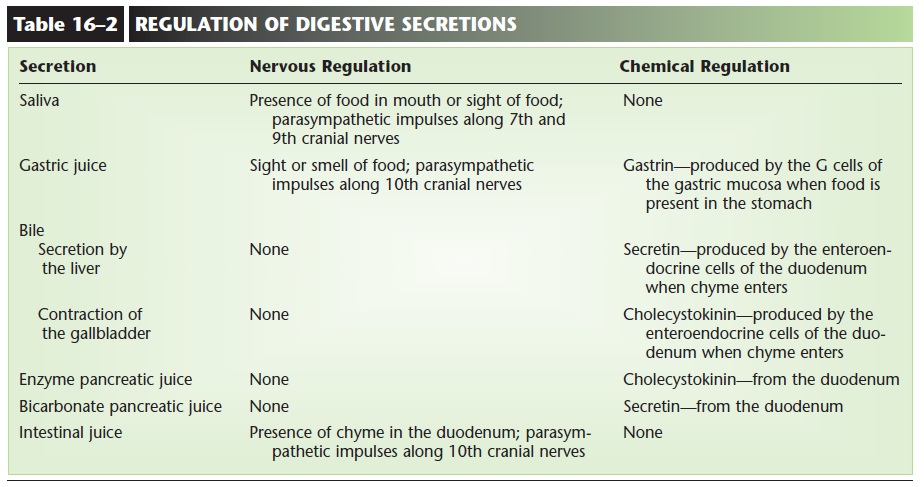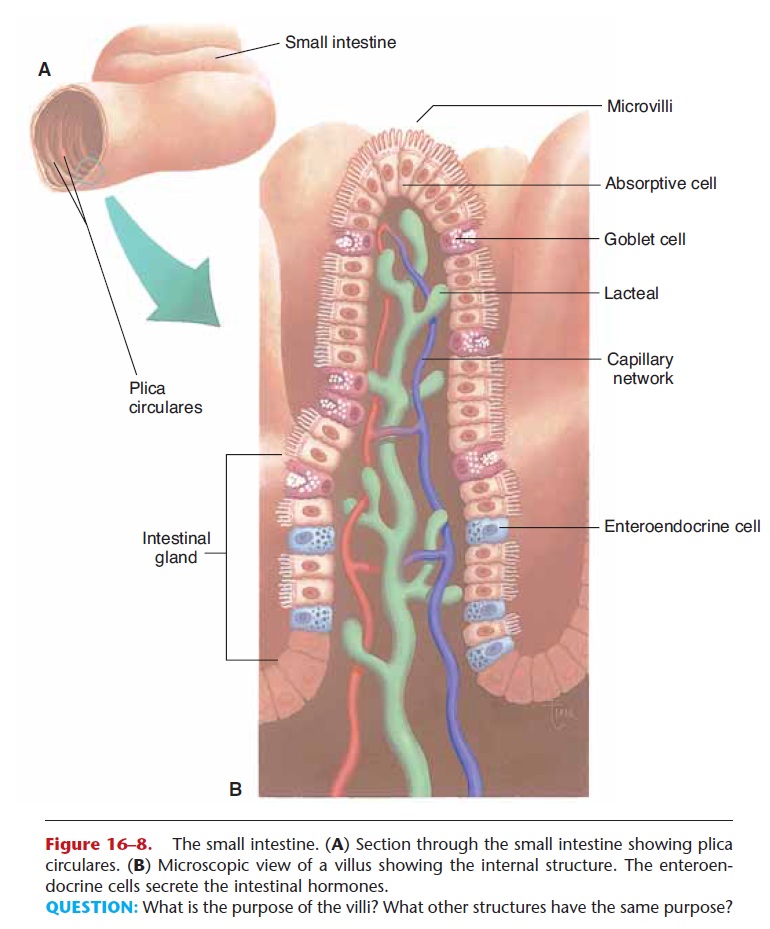Chapter: Essentials of Anatomy and Physiology: The Digestive System
Completion of Digestion and Absorption
COMPLETION OF DIGESTION AND ABSORPTION
SMALL INTESTINE
The secretion of the epithelium of the intestinal glands (or crypts of Lieberkühn) is stimulated by the
The intestinal enzymes are the peptidases and sucrase, maltase, and lactase. Peptidases complete the digestion of protein by breaking down short polypeptide chains to amino acids. Sucrase, maltase, and lactase, respectively, digest the disaccharides sucrose, maltose, and lactose to monosaccharides.
The enteroendocrine cells of the intestinal glands secrete the hormones of the small intestine. Secretion is stimulated by food entering the duodenum.


A summary of the digestive secretions and their functions is found in Table 16–1. Regulation of these secretions is shown in Table 16–2.
ABSORPTION
Most absorption of the end products of digestion takes place in the small intestine (although the stomach does absorb water and alcohol). The process of absorption requires a large surface area, which is provided by sev- eral structural modifications of the small intestine; these are shown in Fig. 16–8. Plica circulares, or cir-cular folds, are macroscopic folds of the mucosa and submucosa, somewhat like accordion pleats. The mucosa is further folded into projections called villi, which give the inner surface of the intestine a velvet-like appearance. Each columnar cell (except the mucus-secreting goblet cells) of the villi also has microvilli on its free surface. Microvilli are micro-scopic folds of the cell membrane, and are collectively

Figure 16–8. The small intestine. (A) Section through the small intestine showing plica circulares. (B) Microscopic view of a villus showing the internal structure. The enteroen-docrine cells secrete the intestinal hormones.
QUESTION: What is the purpose of the villi? What other structures have the same purpose?
called the brush border. All of these folds greatly increase the surface area of the intestinal lining. It is estimated that if the intestinal mucosa could be flat-tened out, it would cover more than 2000 square feet (half a basketball court).
The absorption of nutrients takes place from the lumen of the intestine into the vessels within the villi. Refer to Fig. 16–8 and notice that within each vil-lus is a capillary network and a lacteal, which is a dead-end lymph capillary. Water-soluble nutrients are absorbed into the blood in the capillary networks. Monosaccharides, amino acids, positive ions, and the water-soluble vitamins (vitamin C and the B vitamins) are absorbed by active transport. Negative ions may be absorbed by either passive or active transport mechanisms. Water is absorbed by osmosis following the absorption of minerals, especially sodium. Certain nutrients have additional special requirements for their absorption: For example, vitamin B12 requires the intrinsic factor produced by the parietal cells of the gastric mucosa, and the efficient absorption of calcium ions requires parathyroid hormone and vita-min D.
Fat-soluble nutrients are absorbed into the lymph in the lacteals of the villi. Bile salts are necessary for the efficient absorption of fatty acids and the fat-solu-ble vitamins (A, D, E, and K). Once absorbed, fatty acids are recombined with glycerol to form triglyc-erides. These triglycerides then form globules that include cholesterol and protein; these lipid–protein complexes are called chylomicrons. In the form of chylomicrons, most absorbed fat is transported by the lymph and eventually enters the blood in the left sub-clavian vein.
Blood from the capillary networks in the villi does not return directly to the heart but first travels through the portal vein to the liver. You may recall the importance of portal circulation. This pathway enables the liver to regulate the blood levels of glucose and amino acids, store certain vitamins, and remove potential poisons from the blood.
Related Topics